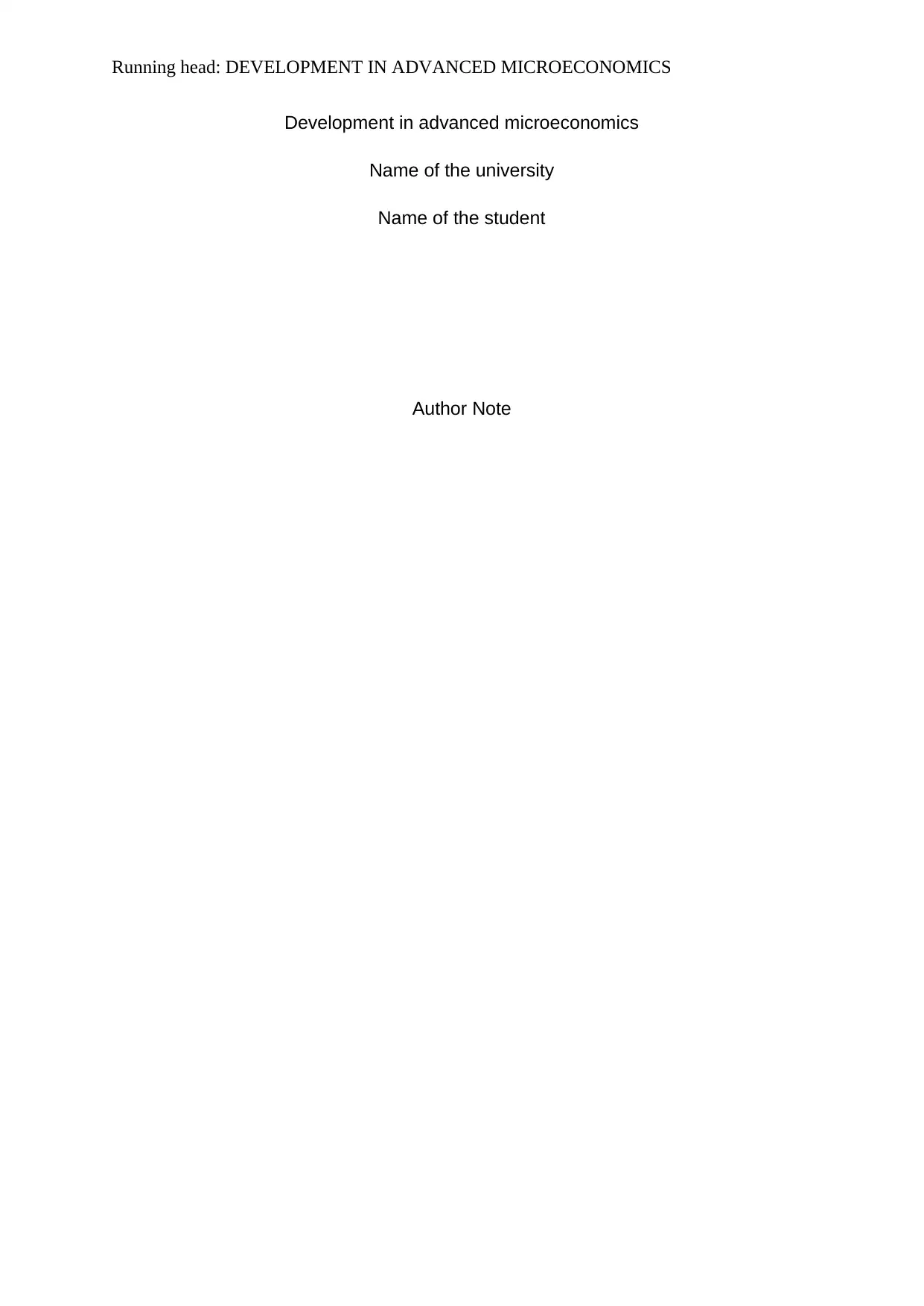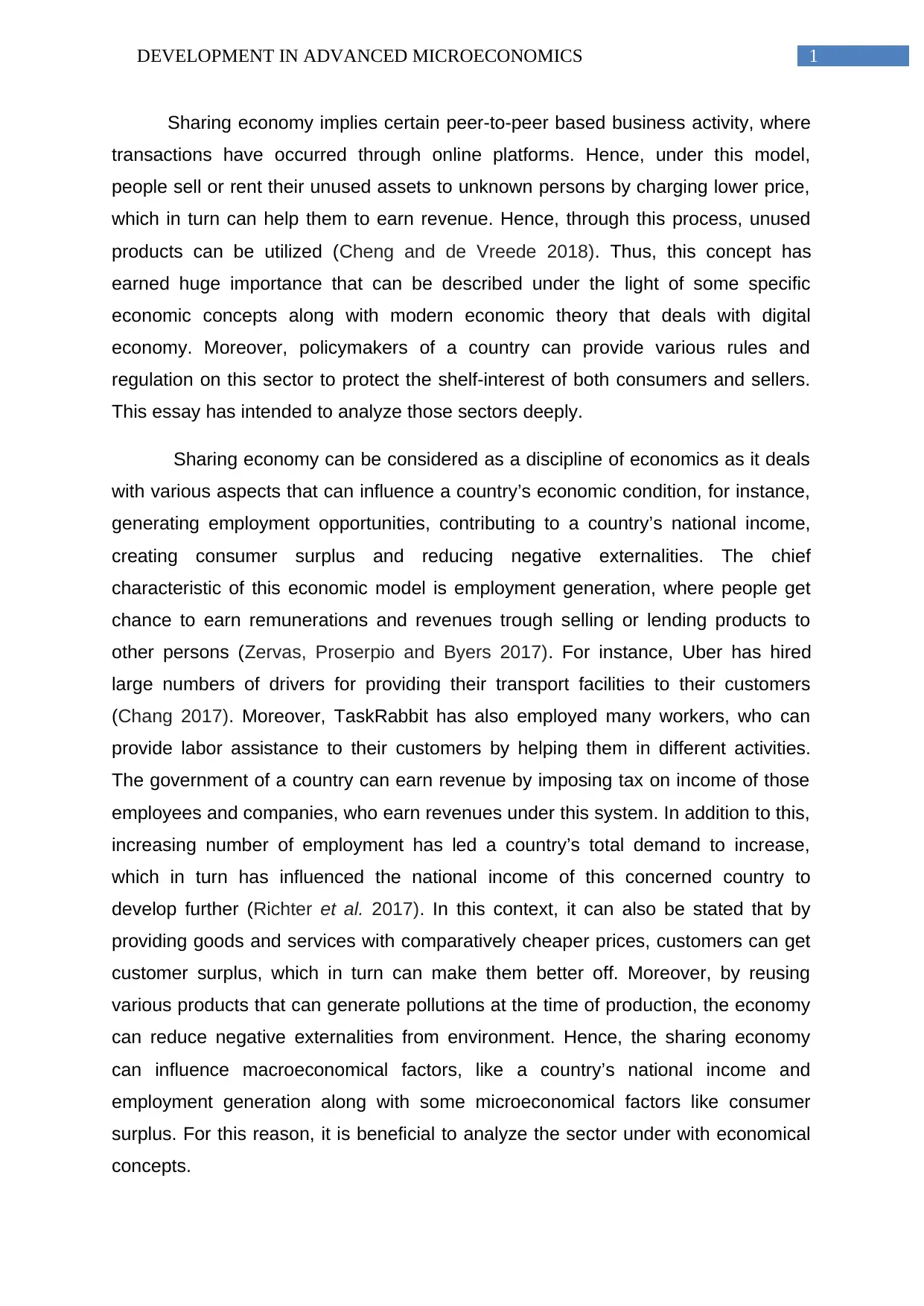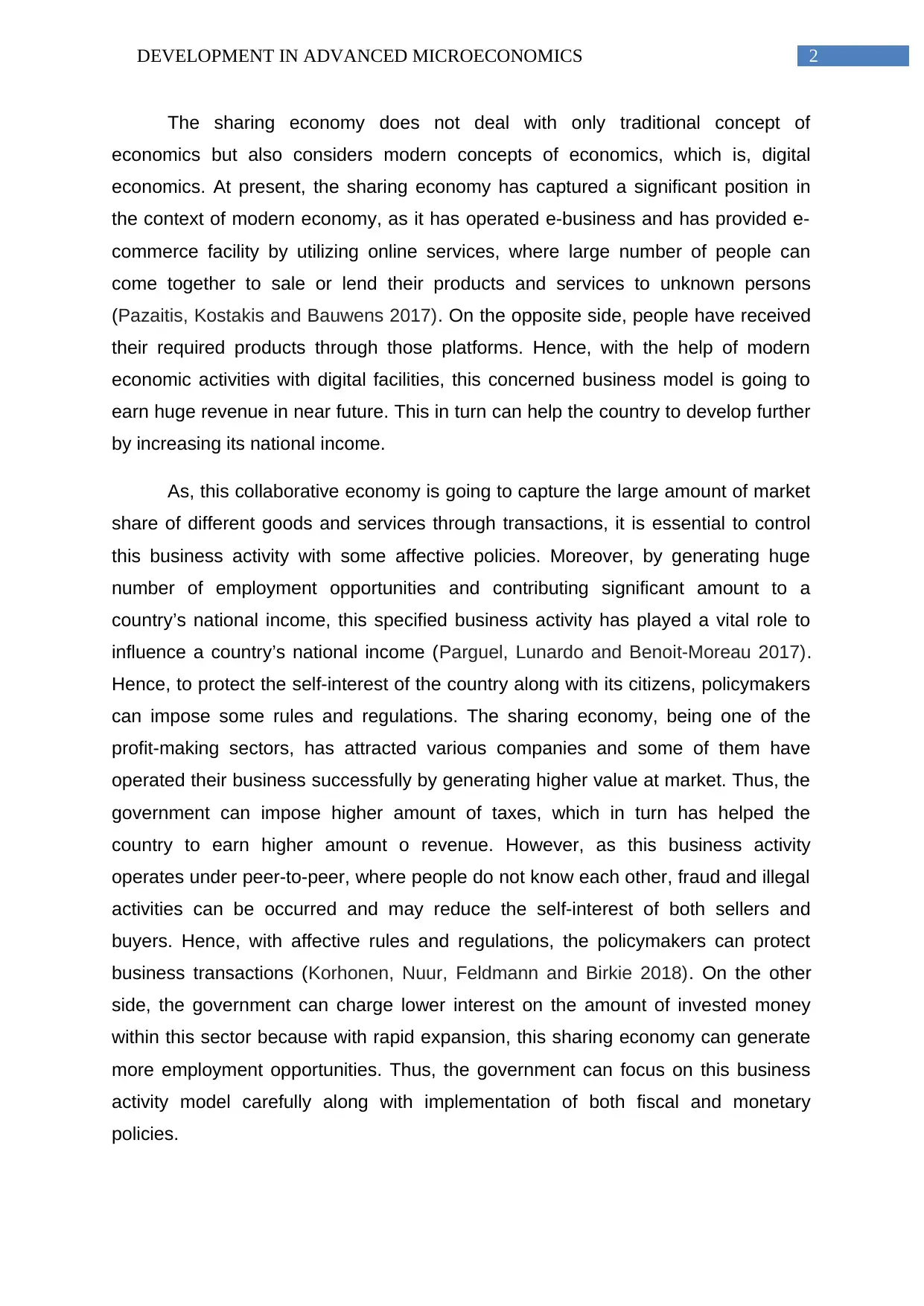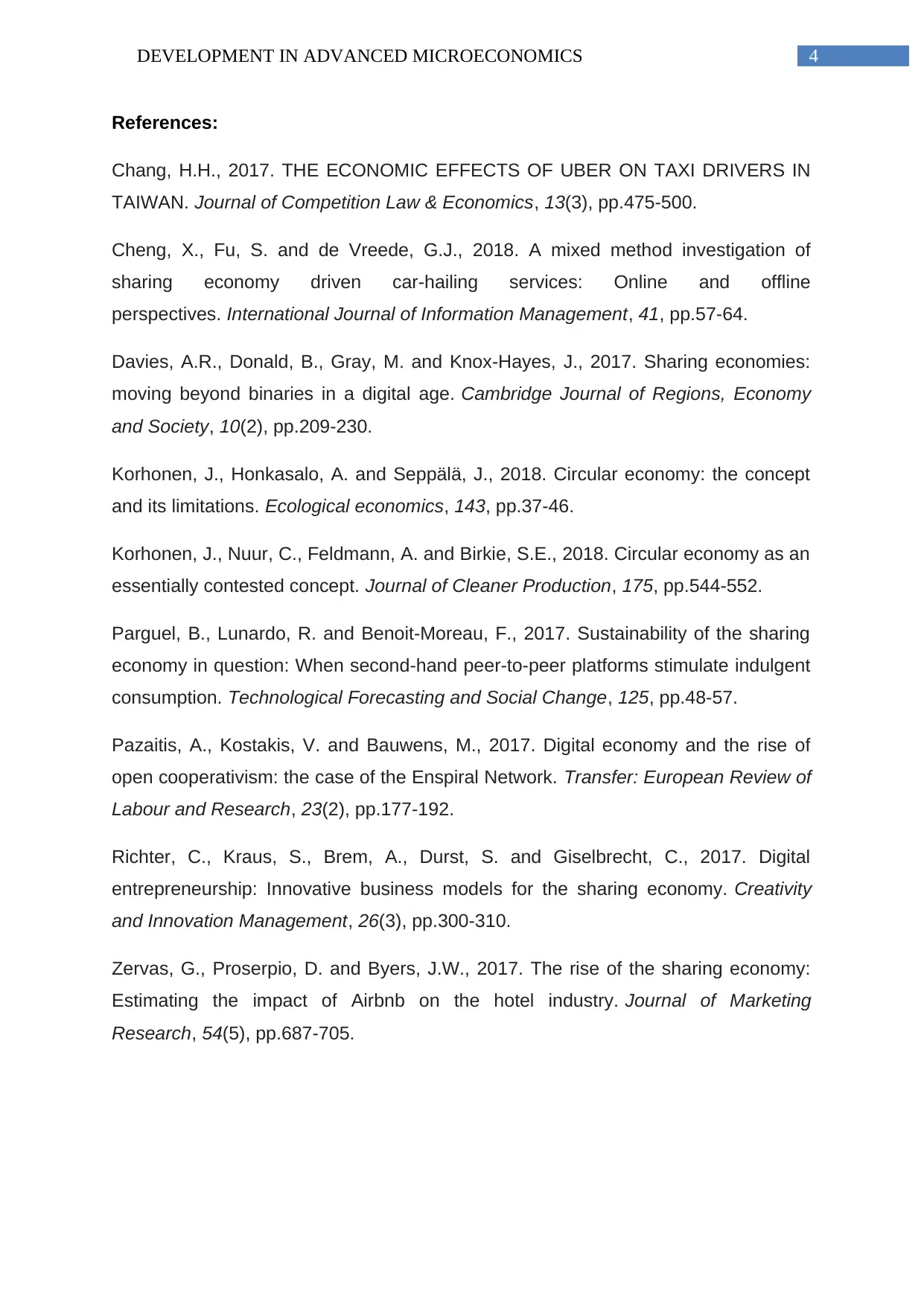ECON3534 - Sharing Economy: Development in Advanced Microeconomics
VerifiedAdded on 2023/06/14
|5
|1618
|497
Essay
AI Summary
This essay examines the development of the sharing economy through the lens of advanced microeconomics, highlighting its influence on employment, national income, and consumer surplus. It considers both traditional and modern economic concepts, including digital economics and e-commerce, while also addressing potential negative impacts such as disruptions to traditional sectors and the risk of fraud. The essay concludes by emphasizing the need for policymakers to implement effective regulations to harness the benefits of the sharing economy while mitigating its potential drawbacks. Desklib provides access to similar solved assignments and resources for students.

Running head: DEVELOPMENT IN ADVANCED MICROECONOMICS
Development in advanced microeconomics
Name of the university
Name of the student
Author Note
Development in advanced microeconomics
Name of the university
Name of the student
Author Note
Paraphrase This Document
Need a fresh take? Get an instant paraphrase of this document with our AI Paraphraser

1DEVELOPMENT IN ADVANCED MICROECONOMICS
Sharing economy implies certain peer-to-peer based business activity, where
transactions have occurred through online platforms. Hence, under this model,
people sell or rent their unused assets to unknown persons by charging lower price,
which in turn can help them to earn revenue. Hence, through this process, unused
products can be utilized (Cheng and de Vreede 2018). Thus, this concept has
earned huge importance that can be described under the light of some specific
economic concepts along with modern economic theory that deals with digital
economy. Moreover, policymakers of a country can provide various rules and
regulation on this sector to protect the shelf-interest of both consumers and sellers.
This essay has intended to analyze those sectors deeply.
Sharing economy can be considered as a discipline of economics as it deals
with various aspects that can influence a country’s economic condition, for instance,
generating employment opportunities, contributing to a country’s national income,
creating consumer surplus and reducing negative externalities. The chief
characteristic of this economic model is employment generation, where people get
chance to earn remunerations and revenues trough selling or lending products to
other persons (Zervas, Proserpio and Byers 2017). For instance, Uber has hired
large numbers of drivers for providing their transport facilities to their customers
(Chang 2017). Moreover, TaskRabbit has also employed many workers, who can
provide labor assistance to their customers by helping them in different activities.
The government of a country can earn revenue by imposing tax on income of those
employees and companies, who earn revenues under this system. In addition to this,
increasing number of employment has led a country’s total demand to increase,
which in turn has influenced the national income of this concerned country to
develop further (Richter et al. 2017). In this context, it can also be stated that by
providing goods and services with comparatively cheaper prices, customers can get
customer surplus, which in turn can make them better off. Moreover, by reusing
various products that can generate pollutions at the time of production, the economy
can reduce negative externalities from environment. Hence, the sharing economy
can influence macroeconomical factors, like a country’s national income and
employment generation along with some microeconomical factors like consumer
surplus. For this reason, it is beneficial to analyze the sector under with economical
concepts.
Sharing economy implies certain peer-to-peer based business activity, where
transactions have occurred through online platforms. Hence, under this model,
people sell or rent their unused assets to unknown persons by charging lower price,
which in turn can help them to earn revenue. Hence, through this process, unused
products can be utilized (Cheng and de Vreede 2018). Thus, this concept has
earned huge importance that can be described under the light of some specific
economic concepts along with modern economic theory that deals with digital
economy. Moreover, policymakers of a country can provide various rules and
regulation on this sector to protect the shelf-interest of both consumers and sellers.
This essay has intended to analyze those sectors deeply.
Sharing economy can be considered as a discipline of economics as it deals
with various aspects that can influence a country’s economic condition, for instance,
generating employment opportunities, contributing to a country’s national income,
creating consumer surplus and reducing negative externalities. The chief
characteristic of this economic model is employment generation, where people get
chance to earn remunerations and revenues trough selling or lending products to
other persons (Zervas, Proserpio and Byers 2017). For instance, Uber has hired
large numbers of drivers for providing their transport facilities to their customers
(Chang 2017). Moreover, TaskRabbit has also employed many workers, who can
provide labor assistance to their customers by helping them in different activities.
The government of a country can earn revenue by imposing tax on income of those
employees and companies, who earn revenues under this system. In addition to this,
increasing number of employment has led a country’s total demand to increase,
which in turn has influenced the national income of this concerned country to
develop further (Richter et al. 2017). In this context, it can also be stated that by
providing goods and services with comparatively cheaper prices, customers can get
customer surplus, which in turn can make them better off. Moreover, by reusing
various products that can generate pollutions at the time of production, the economy
can reduce negative externalities from environment. Hence, the sharing economy
can influence macroeconomical factors, like a country’s national income and
employment generation along with some microeconomical factors like consumer
surplus. For this reason, it is beneficial to analyze the sector under with economical
concepts.

2DEVELOPMENT IN ADVANCED MICROECONOMICS
The sharing economy does not deal with only traditional concept of
economics but also considers modern concepts of economics, which is, digital
economics. At present, the sharing economy has captured a significant position in
the context of modern economy, as it has operated e-business and has provided e-
commerce facility by utilizing online services, where large number of people can
come together to sale or lend their products and services to unknown persons
(Pazaitis, Kostakis and Bauwens 2017). On the opposite side, people have received
their required products through those platforms. Hence, with the help of modern
economic activities with digital facilities, this concerned business model is going to
earn huge revenue in near future. This in turn can help the country to develop further
by increasing its national income.
As, this collaborative economy is going to capture the large amount of market
share of different goods and services through transactions, it is essential to control
this business activity with some affective policies. Moreover, by generating huge
number of employment opportunities and contributing significant amount to a
country’s national income, this specified business activity has played a vital role to
influence a country’s national income (Parguel, Lunardo and Benoit-Moreau 2017).
Hence, to protect the self-interest of the country along with its citizens, policymakers
can impose some rules and regulations. The sharing economy, being one of the
profit-making sectors, has attracted various companies and some of them have
operated their business successfully by generating higher value at market. Thus, the
government can impose higher amount of taxes, which in turn has helped the
country to earn higher amount o revenue. However, as this business activity
operates under peer-to-peer, where people do not know each other, fraud and illegal
activities can be occurred and may reduce the self-interest of both sellers and
buyers. Hence, with affective rules and regulations, the policymakers can protect
business transactions (Korhonen, Nuur, Feldmann and Birkie 2018). On the other
side, the government can charge lower interest on the amount of invested money
within this sector because with rapid expansion, this sharing economy can generate
more employment opportunities. Thus, the government can focus on this business
activity model carefully along with implementation of both fiscal and monetary
policies.
The sharing economy does not deal with only traditional concept of
economics but also considers modern concepts of economics, which is, digital
economics. At present, the sharing economy has captured a significant position in
the context of modern economy, as it has operated e-business and has provided e-
commerce facility by utilizing online services, where large number of people can
come together to sale or lend their products and services to unknown persons
(Pazaitis, Kostakis and Bauwens 2017). On the opposite side, people have received
their required products through those platforms. Hence, with the help of modern
economic activities with digital facilities, this concerned business model is going to
earn huge revenue in near future. This in turn can help the country to develop further
by increasing its national income.
As, this collaborative economy is going to capture the large amount of market
share of different goods and services through transactions, it is essential to control
this business activity with some affective policies. Moreover, by generating huge
number of employment opportunities and contributing significant amount to a
country’s national income, this specified business activity has played a vital role to
influence a country’s national income (Parguel, Lunardo and Benoit-Moreau 2017).
Hence, to protect the self-interest of the country along with its citizens, policymakers
can impose some rules and regulations. The sharing economy, being one of the
profit-making sectors, has attracted various companies and some of them have
operated their business successfully by generating higher value at market. Thus, the
government can impose higher amount of taxes, which in turn has helped the
country to earn higher amount o revenue. However, as this business activity
operates under peer-to-peer, where people do not know each other, fraud and illegal
activities can be occurred and may reduce the self-interest of both sellers and
buyers. Hence, with affective rules and regulations, the policymakers can protect
business transactions (Korhonen, Nuur, Feldmann and Birkie 2018). On the other
side, the government can charge lower interest on the amount of invested money
within this sector because with rapid expansion, this sharing economy can generate
more employment opportunities. Thus, the government can focus on this business
activity model carefully along with implementation of both fiscal and monetary
policies.
⊘ This is a preview!⊘
Do you want full access?
Subscribe today to unlock all pages.

Trusted by 1+ million students worldwide

3DEVELOPMENT IN ADVANCED MICROECONOMICS
This peer-to-peer economy does not only provide some positive impacts, but
also can influence the economic structure of a country with some negative
implications. After sudden increase of this specified economic model, various
traditional sectors like car service of yellow taxi has affected inversely, this in turn
has reduced the employment opportunities of this sector. This negative phenomenon
can affect the country’s national income adversely as it has led the per capita income
of this concerned country to decrease (Davies, Donald, Gray and Knox-Hayes 2017).
This situation has further reduced the aggregate demand of the economy. Hence,
the country can experience a loss from overall implications of both sharing economy
along with traditional sectors. In addition to this, social welfare can be influence as
well. On the one hand, consumers have received opportunities to earn consumer
surplus while providers have also received chances to earn revenue by lending or
selling their unused products in market and this consequently has generated welfare
economic and social welfare. On the other hand, huge expansion of this digital
market has led the people of traditional sectors to scarify their jobs (Korhonen,
Honkasalo and Seppälä 2018). In addition to this, peer-to-peer service has helped
the economy to make good relation among people as they directly have
communicate within the business activity. However, under sharing economy, both
buyers and sellers can perform illegal activities that further can destroy thesocial
relationship between people. Hence, the sector has possessed both advantages and
disadvantages.
Thus, it can be concluded that the sharing economy is expanding its business
rapidly at present with its huge economic significant. Through this business activity, a
country can generate its employment opportunities along with development in its
national income. Those impacts of sharing economy can be described with the help
of some economic concepts. Hence, policymakers need to take proper decisions for
controlling this economy as it has both advantages and disadvantage.
This peer-to-peer economy does not only provide some positive impacts, but
also can influence the economic structure of a country with some negative
implications. After sudden increase of this specified economic model, various
traditional sectors like car service of yellow taxi has affected inversely, this in turn
has reduced the employment opportunities of this sector. This negative phenomenon
can affect the country’s national income adversely as it has led the per capita income
of this concerned country to decrease (Davies, Donald, Gray and Knox-Hayes 2017).
This situation has further reduced the aggregate demand of the economy. Hence,
the country can experience a loss from overall implications of both sharing economy
along with traditional sectors. In addition to this, social welfare can be influence as
well. On the one hand, consumers have received opportunities to earn consumer
surplus while providers have also received chances to earn revenue by lending or
selling their unused products in market and this consequently has generated welfare
economic and social welfare. On the other hand, huge expansion of this digital
market has led the people of traditional sectors to scarify their jobs (Korhonen,
Honkasalo and Seppälä 2018). In addition to this, peer-to-peer service has helped
the economy to make good relation among people as they directly have
communicate within the business activity. However, under sharing economy, both
buyers and sellers can perform illegal activities that further can destroy thesocial
relationship between people. Hence, the sector has possessed both advantages and
disadvantages.
Thus, it can be concluded that the sharing economy is expanding its business
rapidly at present with its huge economic significant. Through this business activity, a
country can generate its employment opportunities along with development in its
national income. Those impacts of sharing economy can be described with the help
of some economic concepts. Hence, policymakers need to take proper decisions for
controlling this economy as it has both advantages and disadvantage.
Paraphrase This Document
Need a fresh take? Get an instant paraphrase of this document with our AI Paraphraser

4DEVELOPMENT IN ADVANCED MICROECONOMICS
References:
Chang, H.H., 2017. THE ECONOMIC EFFECTS OF UBER ON TAXI DRIVERS IN
TAIWAN. Journal of Competition Law & Economics, 13(3), pp.475-500.
Cheng, X., Fu, S. and de Vreede, G.J., 2018. A mixed method investigation of
sharing economy driven car-hailing services: Online and offline
perspectives. International Journal of Information Management, 41, pp.57-64.
Davies, A.R., Donald, B., Gray, M. and Knox-Hayes, J., 2017. Sharing economies:
moving beyond binaries in a digital age. Cambridge Journal of Regions, Economy
and Society, 10(2), pp.209-230.
Korhonen, J., Honkasalo, A. and Seppälä, J., 2018. Circular economy: the concept
and its limitations. Ecological economics, 143, pp.37-46.
Korhonen, J., Nuur, C., Feldmann, A. and Birkie, S.E., 2018. Circular economy as an
essentially contested concept. Journal of Cleaner Production, 175, pp.544-552.
Parguel, B., Lunardo, R. and Benoit-Moreau, F., 2017. Sustainability of the sharing
economy in question: When second-hand peer-to-peer platforms stimulate indulgent
consumption. Technological Forecasting and Social Change, 125, pp.48-57.
Pazaitis, A., Kostakis, V. and Bauwens, M., 2017. Digital economy and the rise of
open cooperativism: the case of the Enspiral Network. Transfer: European Review of
Labour and Research, 23(2), pp.177-192.
Richter, C., Kraus, S., Brem, A., Durst, S. and Giselbrecht, C., 2017. Digital
entrepreneurship: Innovative business models for the sharing economy. Creativity
and Innovation Management, 26(3), pp.300-310.
Zervas, G., Proserpio, D. and Byers, J.W., 2017. The rise of the sharing economy:
Estimating the impact of Airbnb on the hotel industry. Journal of Marketing
Research, 54(5), pp.687-705.
References:
Chang, H.H., 2017. THE ECONOMIC EFFECTS OF UBER ON TAXI DRIVERS IN
TAIWAN. Journal of Competition Law & Economics, 13(3), pp.475-500.
Cheng, X., Fu, S. and de Vreede, G.J., 2018. A mixed method investigation of
sharing economy driven car-hailing services: Online and offline
perspectives. International Journal of Information Management, 41, pp.57-64.
Davies, A.R., Donald, B., Gray, M. and Knox-Hayes, J., 2017. Sharing economies:
moving beyond binaries in a digital age. Cambridge Journal of Regions, Economy
and Society, 10(2), pp.209-230.
Korhonen, J., Honkasalo, A. and Seppälä, J., 2018. Circular economy: the concept
and its limitations. Ecological economics, 143, pp.37-46.
Korhonen, J., Nuur, C., Feldmann, A. and Birkie, S.E., 2018. Circular economy as an
essentially contested concept. Journal of Cleaner Production, 175, pp.544-552.
Parguel, B., Lunardo, R. and Benoit-Moreau, F., 2017. Sustainability of the sharing
economy in question: When second-hand peer-to-peer platforms stimulate indulgent
consumption. Technological Forecasting and Social Change, 125, pp.48-57.
Pazaitis, A., Kostakis, V. and Bauwens, M., 2017. Digital economy and the rise of
open cooperativism: the case of the Enspiral Network. Transfer: European Review of
Labour and Research, 23(2), pp.177-192.
Richter, C., Kraus, S., Brem, A., Durst, S. and Giselbrecht, C., 2017. Digital
entrepreneurship: Innovative business models for the sharing economy. Creativity
and Innovation Management, 26(3), pp.300-310.
Zervas, G., Proserpio, D. and Byers, J.W., 2017. The rise of the sharing economy:
Estimating the impact of Airbnb on the hotel industry. Journal of Marketing
Research, 54(5), pp.687-705.
1 out of 5
Related Documents
Your All-in-One AI-Powered Toolkit for Academic Success.
+13062052269
info@desklib.com
Available 24*7 on WhatsApp / Email
![[object Object]](/_next/static/media/star-bottom.7253800d.svg)
Unlock your academic potential
Copyright © 2020–2025 A2Z Services. All Rights Reserved. Developed and managed by ZUCOL.




